First Flight:
John Oliver
![]()
First Flight:
|
|
by Alfred Scott
|
This article appeared in the September 1989 Falco Builders Letter. |
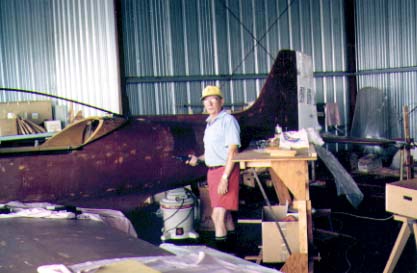
John Oliver in the final stages of construction.
Congratulations to John Oliver, whose Falco flew for the first time on September 12, thus becoming the 23rd Sequoia Falco to fly. The initial test flights were made by John's son, Paul, an Air Force F-16 pilot who has about 300 recent hours in a Pitts S2A. Part of Paul's job is to flight test F-16s after work has been performed on them, so Paul was ideally qualified to test the Falco, and John readily accepted Paul's offer to do the testing.
Paul took two weeks off from the Air Force and spent the time very methodically testing the aircraft. On the first day, he did about three or four high speed taxi tests and then flew it. He held it on the ground to 80 knots, to insure that he was well into the flight envelope, and then the plane jumped into the air. Paul kept the gear down and reported that the only problem was a very slightly heavy right wing that produced a 2°/second right roll rate.
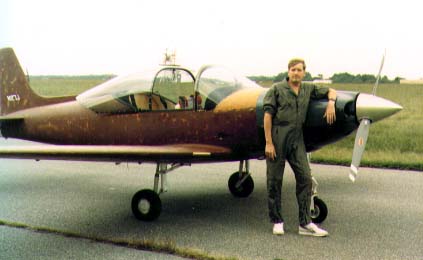
Paul Oliver
Paul was very happy with the way it flew. On stalls, he reported "5 knots of tickle, then it rolls off hard left. The airplane talks to you just fine-'you're going to stall.'" Paul said that landings are a "piece of cake" and that ground handling is much easier than the Pitts.
The next day was gear test day and the gear would not retract electrically. Paul cranked the gear up by hand and reported that a power setting of 24/2400 gives 130+ knots indicated. The plane does not have fairings and gear doors installed at this time. There were a number of other little electrical problems-no CHT reading and the load-reading ammeter stopped working after takeoff. These are the types of little electrical glitches that most people experience. The landing gear problem has been traced to the pitot-pressure switch-either there is a loose connection or the switch is faulty-since they bypassed the switch with the jumper used for ground retraction tests and the gear retracted normally in flight.
The problem with the load-reading ammeter turned out to be a problem with something else. On the ground the battery was charging after starting and the load-reading ammeter showed a load of about 20 amps. Once in the air, the ammeter showed a slight discharge, the low voltage light came on, the load-reading ammeter showed no load, and the voltmeter showed about 12 volts. The problem is really with the charging circuit, and I thought it was probably with a loose field wire to the alternator.
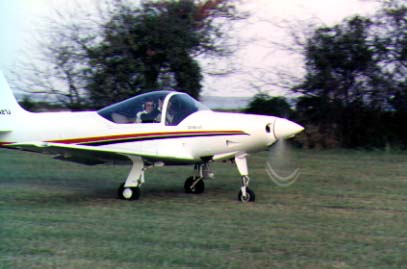
Finished and painted, John and Midge take off at the Oyster Fly-In.
I remember that Dave Aronson had a problem with his alternator field wire. The thing broke off on every flight, apparently from vibration, and Dave finally used a slightly heavier-gauge wire in hopes that it would not have the same harmonic frequency. Whatever the reason, the new wire worked nicely.
John reports that now with about four hours on the plane, they are still buffaloed by the alternator, which stops working at about 90 knots. They have checked all connections and find them tight. The alternator works perfectly on the ground, and he is beginning to suspect that the problem is in the alternator itself.
In anticipation that a wing would be heavy, John made an aileron trim tab so that it was about nine inches long and stuck out from the trailing edge by about an inch and a half. To correct for the slight wing-heaviness, he bent it about 20° and Paul was presented with a rude surprise when he next flew the plane, although he didn't have any difficulty in flying it. For those of you who don't know, you only have to bend an aileron trim tab the very slightest amount. These things are surprisingly powerful, and you only need two or three millimeters to get an effect. Twenty degrees from neutral is an enormous amount of trim.
At the time he bought the Falco plans in February 1980, John Oliver had retired from Du Pont where he had worked as an engineer. He worked on the aircraft on a steady schedule at home and then moved the project to the Wilmington, Delaware, airport where he finished the plane. John is one of our early builders and suffered through that period when we were eliminating errors from the drawings.
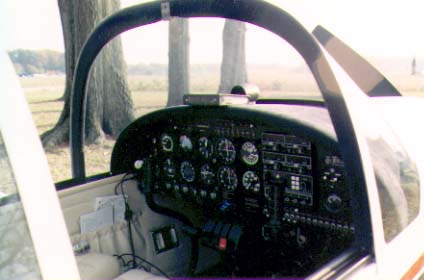
The Falco came in at 1,277 lbs empty with a 64.71" CG, with a 160 hp IO-320-B1A and constant-speed propeller. John tried to get a registration number that ended with his initials of JO, but the FAA won't use the letter O since it looks so much a zero. So when he saw he wasn't going to get anywhere with that, he asked them for the lowest available number that ended with a J and received N27J.
John was a relatively low-time pilot when he began work on the Falco, but he and his wife, Midge, have an Archer which they both fly regularly. As I was writing this, I called John to see if he had flown the Falco. He said he had just come back from his first flight in the plane. He said he finds it a "nice flying airplane -- a real pleasure to fly" and also with the as-described light controls. Paul will be checking John out in the airplane during the rest of the week. For his part, John is very glad he had someone else do the flight testing, and says that "anybody who tries to test fly this plane who hasn't been flying this sort of plane has got rocks in his head."
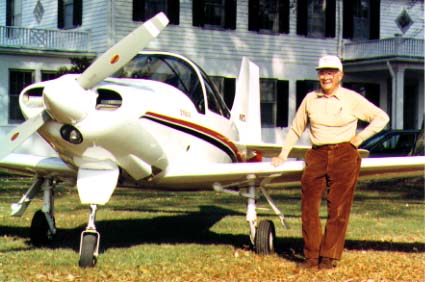
John Oliver
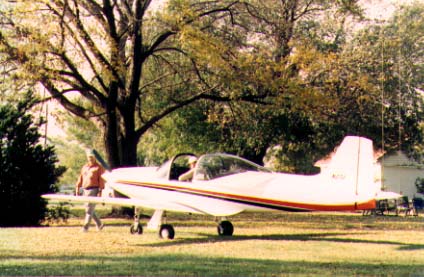
|
|